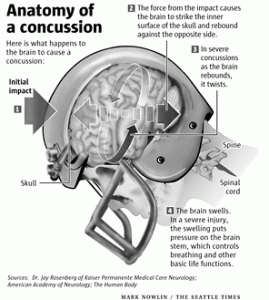
With football season well underway, no injury is receiving more attention than concussions. Covering the sidelines on Friday nights, I have already treated a football player with a concussion.
Receiving press prior to last week’s Alabama vs. Arkansas game was the question…Would Tyler Wilson, Arkansas quarterboack, be able to return after a concussion a week earlier. His ability to play was thought to be a big factor in whether Arkansas could compete with Alabama.
This scenario highlights the dilemma we face regarding when to return the injured athlete to play after a concussion. During the last two years the NFL has invested a lot of effort in improving the diagnosis and treatment for concussions, but more importantly the have worked to minimize potential long term consequences.
A concussion is a brain injury that occurs either after a direct blow to the head or by indirect forces applied to the head. This disturbs the normal physiology of brain transmissions and thus causes symptoms.
What are symptoms of a concussion.
There may be a loss of consciences which makes the diagnosis easy. There can be personality changes such as slowness or inappropriate responses to questions. There may also be dizziness, nausea, headache, and or unsteadiness. This is almost always a transient situation with a rare chance for permanent damage at the time of injury. However, recognition of a concussion is essential when determining the appropriate treatment and preventing further injury.
What to do when a concussion occurs?
Once a concussion is suspected, an evaluation including a series of questions and a physical examination is performed on the sideline. If the diagnosis is confirmed or highly suspected, the athlete should be held out of play for the rest of the game and followed closely afterward before return to play. If the evaluation is negative, the athlete is placed through exercise on the sideline to make sure symptoms do not occur. Then he may return to play.
When can athlete return to play?
If a player has been held out, the hardest decision is when to return the athlete to play. Many schools are now using standardized tests. Preseason testing is performed and then compared to post injury testing. A return to the baseline test is an indication to return to play. The Alabama High School Athletic Association now requires a physician clearance to return to play. In general, the athlete should be rested both physically and mentally until all symptoms are gone. Once symptom free, there is a progession of return. First the athlete will being general light exersice, followed by sports specific exercise. If there is not return of symtoms, they may return to practice followed by participation in competition.
There is still much to learn about this injury. We know the risk of a concussion during the same season is 3 times greater after a first concussion. The risk over the athletes career may be as high as 25% for recurrent concussions. So how do we do a better job preventing them? No helmet has been shown to reduce the rate of injury. Equipment changes hopefully will make a difference in the future. We are optimistic that rule changes will result in a reduction of concussions as well. We still don’t understand the long term consequences of this injury.
It is quite evident there is a heightened awareness of concussions. As a result, better treatment and outcomes will occur. We have come a long way in handling this injury, but much still has to be learned. As a result treatment and prevention should improve outcomes.
Eric W. Janssen, MD


 January 11th, 2013
January 11th, 2013  Suzie Sanders
Suzie Sanders 
 Posted in
Posted in